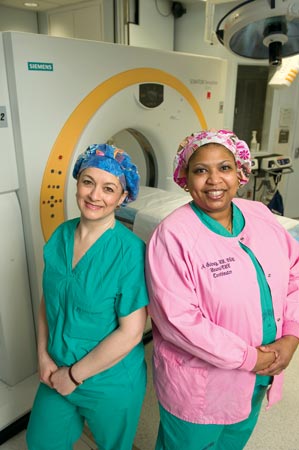Nurses help bring new imaging technology to the OR
By Stephanie Shapiro

Before the November launch of the intraoperative CT (iCT) at Johns Hopkins Bayview Medical Center, Allison Godsey, RN, CNOR, clinical coordinator for neurosurgery, and Brigida Walston, RN, were well acquainted with the sophisticated technology.
Months earlier, the two women traveled with a multidisciplinary team to St. Joe’s Carondelet Neurological Institute, site of the country’s only other dual-room iCT. There, Godsey and Walston got to see the scanner in use and to troubleshoot with healthcare peers at the Tucson hospital.
“That trip really helped us to actually see cases going on first hand, to see how they had their room set up, how to position patients and to talk with staff members to know what issues they had,” Godsey says.
By providing real-time imagery during complex surgeries, the iCT brings a new level of treatment capability to the OR. Integrated with a surgical navigation system, the technology will help surgeons to pinpoint brain tumors or place screws into the spine with greater precision. In addition, nurses no longer have to break the sterile field to move a patient to the radiology department for a CT and possibly back to the OR for further surgery, lowering the risk of complications.
From the start, Godsey and Walston have played an integral role in the installation and operation of the iCT, which is mounted on rails so it can slide over patients in two adjacent operating rooms. Versed by their Tucson experience, the two nurses reconfigured both ORs to make way for the new imaging technology.
After rearranging providers’ stations, supplies, monitors and other equipment, they also helped the neurosurgery team “get accustomed to where things are stored and to become comfortable with the new setup,” Godsey says.
Particularly important is guarding against inadvertent damage to the iCT during surgery. “You have to be very cognizant of the tracks the iCT runs on,” Godsey says. “You can’t run equipment over those tracks, because the inner workings are right underneath.”
Godsey also helped to coordinate four-hour iCT training sessions for twelve nurses, starting with the basics: “How to shut the whole system on and off and then how to have the room up and running for the morning.”
As they gain expertise, from learning the best ways to position patients to honing their documentation, Hopkins Bayview’s neuro nurses will be able to make increasingly sophisticated use of the CT scanner, further improving patient care.
For Godsey, who is helping to lead the ongoing training effort, that means staying ahead of the curve. “The more I learn,” she says, “the more I’m the one pushing the buttons.”
